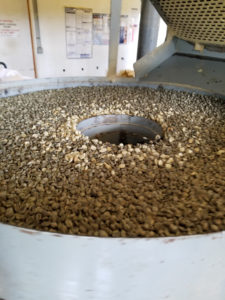
coffee processing involve removing the last layers of dry skin and remaining fruit residue from the dried coffee cherries, then cleaning and sorting it.
Hulling
First step in dry milling is the removal of what is left of the fruit from the bean, whether it is the crumbly parchment skin of washed coffee, the parchment skin and dried mucilage of
semi-washed coffee, or the entire dry, leathery fruit covering of the natural processed coffee. Hulling is done with the help our Pinhalense machine manufactured in Brazil, which gently shakes the coffee.
Cleaning and Sorting
Next the coffee is cleaned and sorted by density of bean and by bean size, all the while removing sticks, rocks, nails, and miscellaneous debris that may have become mixed with the coffee during drying. First machines blow the beans into the air; those that fall into bins closest to the air source are heaviest and biggest; the lightest (and likely defective) beans plus chaff are blown in the farthest bin. Other machines shake the beans through a series of sieves, sorting them by size. Our machine sorts sizes Fancy, Hawaii #1 and Peaberry. Check out our green bean page Here to see the different sizes.
Finally, a machine called a gravity separator shakes the sized beans on a tilted table, so that the heaviest, densest and best vibrate to one side of the pulsating table, and the lightest to the other.
Grading
Finally grading occurs, which is the process of categorizing coffee beans on the basis of various criteria such as size of the bean, where and at what altitude it was grown, how it was prepared and picked, how good it tastes, or its cup quality. Coffees also may be graded by the number of imperfections (defective and broken beans, pebbles, sticks, etc.) per sample.
We impose a level of quality control that goes well beyond conventionally defined grading criteria, because we want our coffee to maintain the industry standards that have gained us global recognition for consistent quality.
Check out the video clips below for an inside view into the Dry Milling Process.


